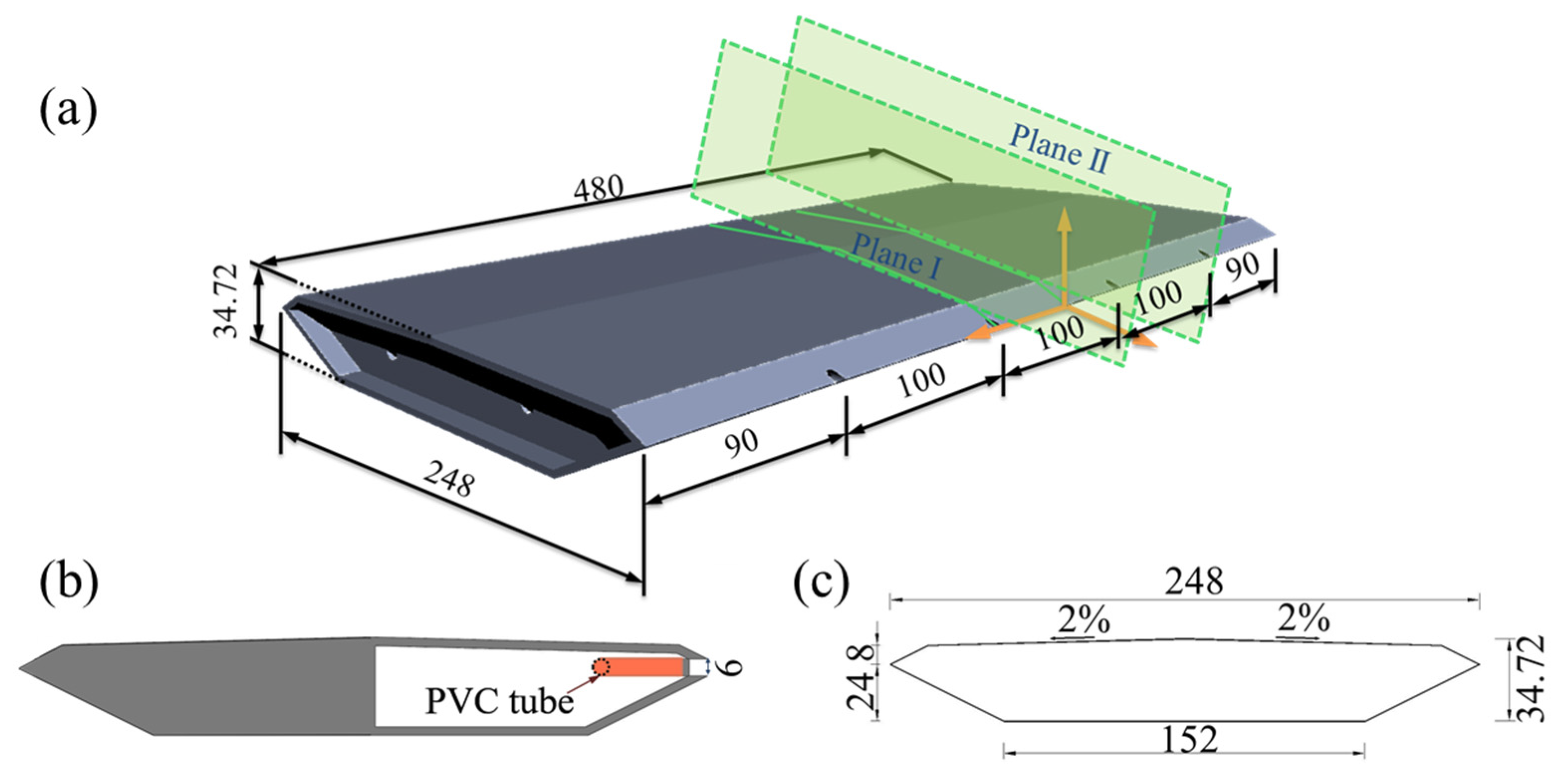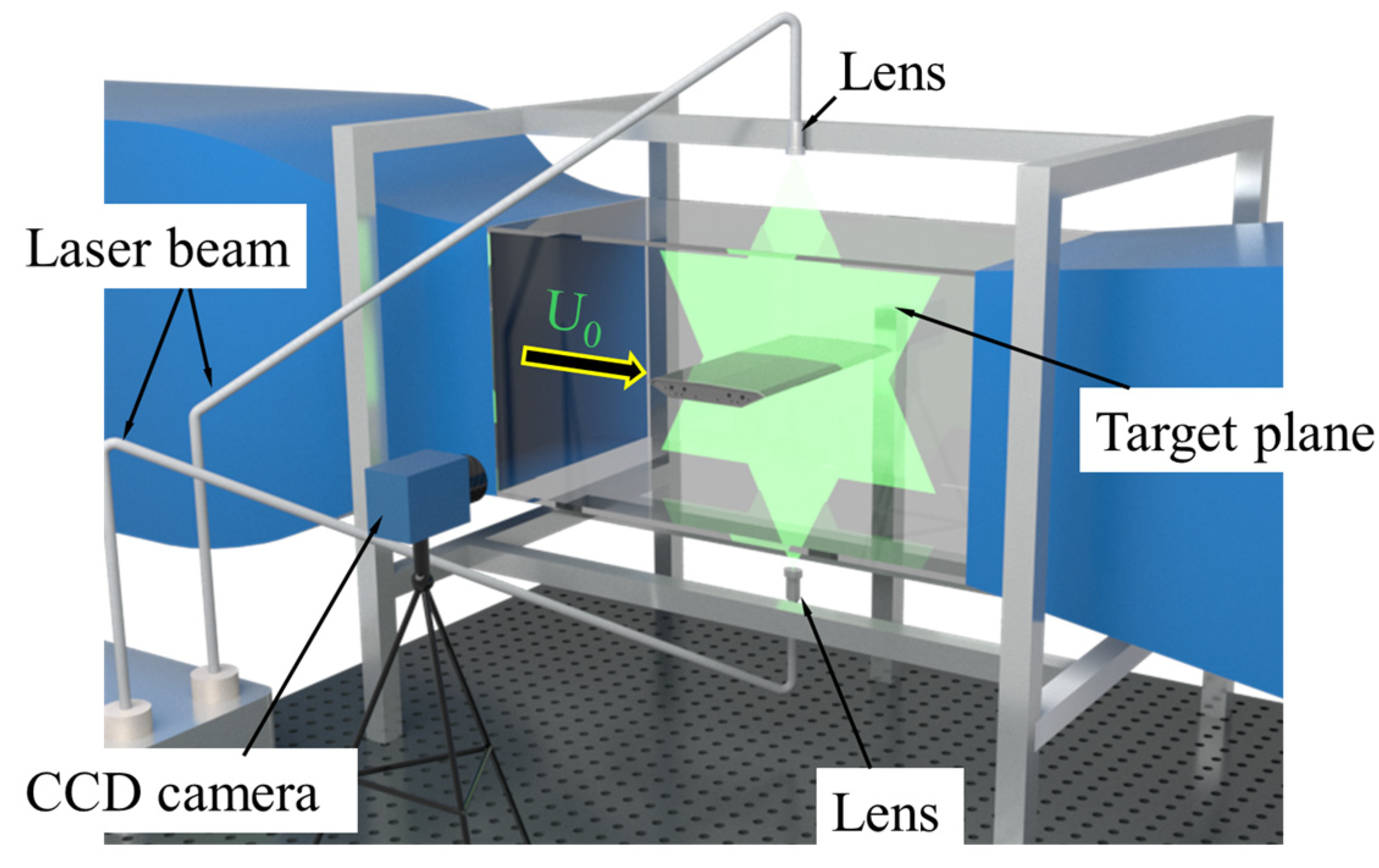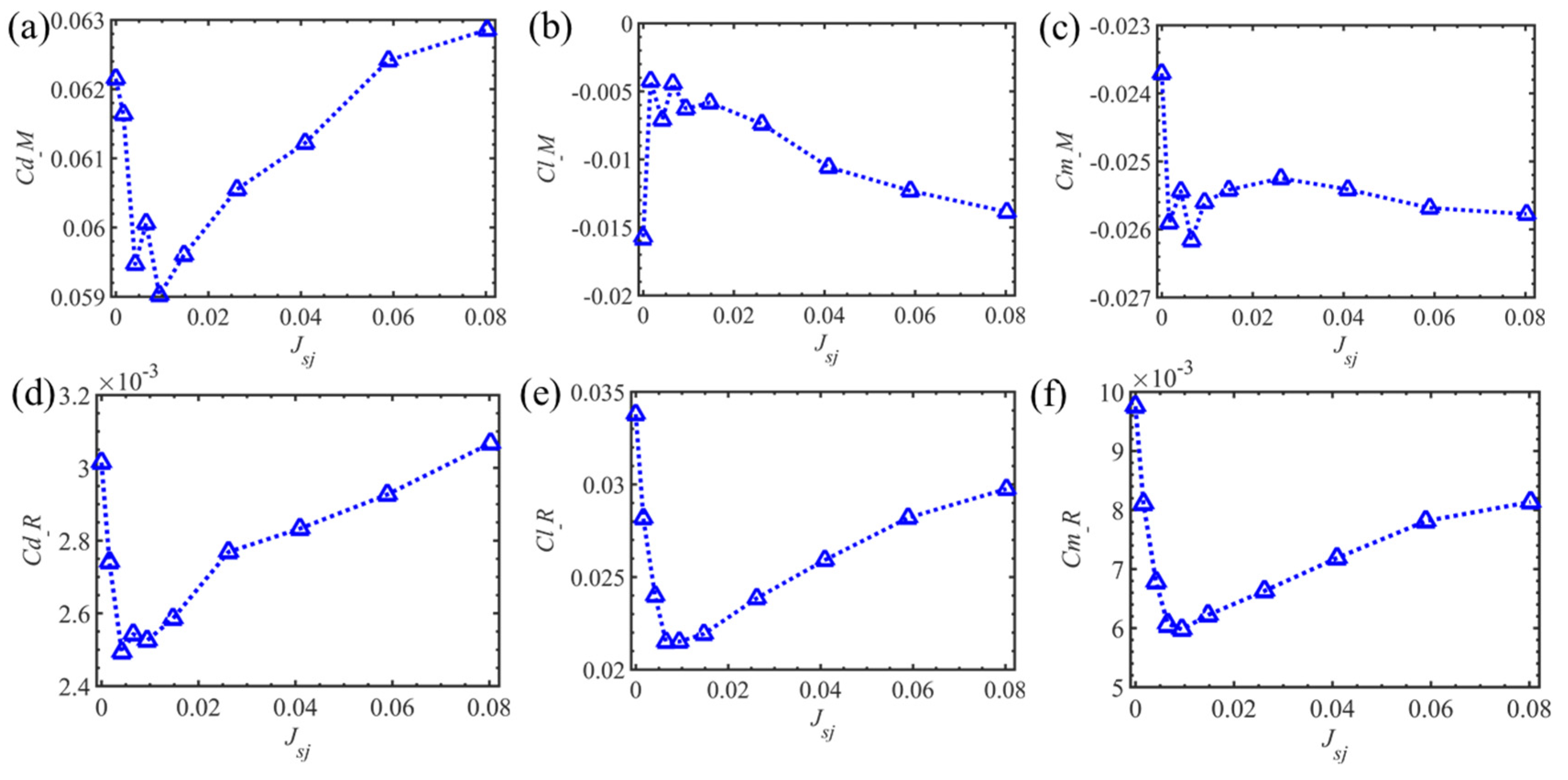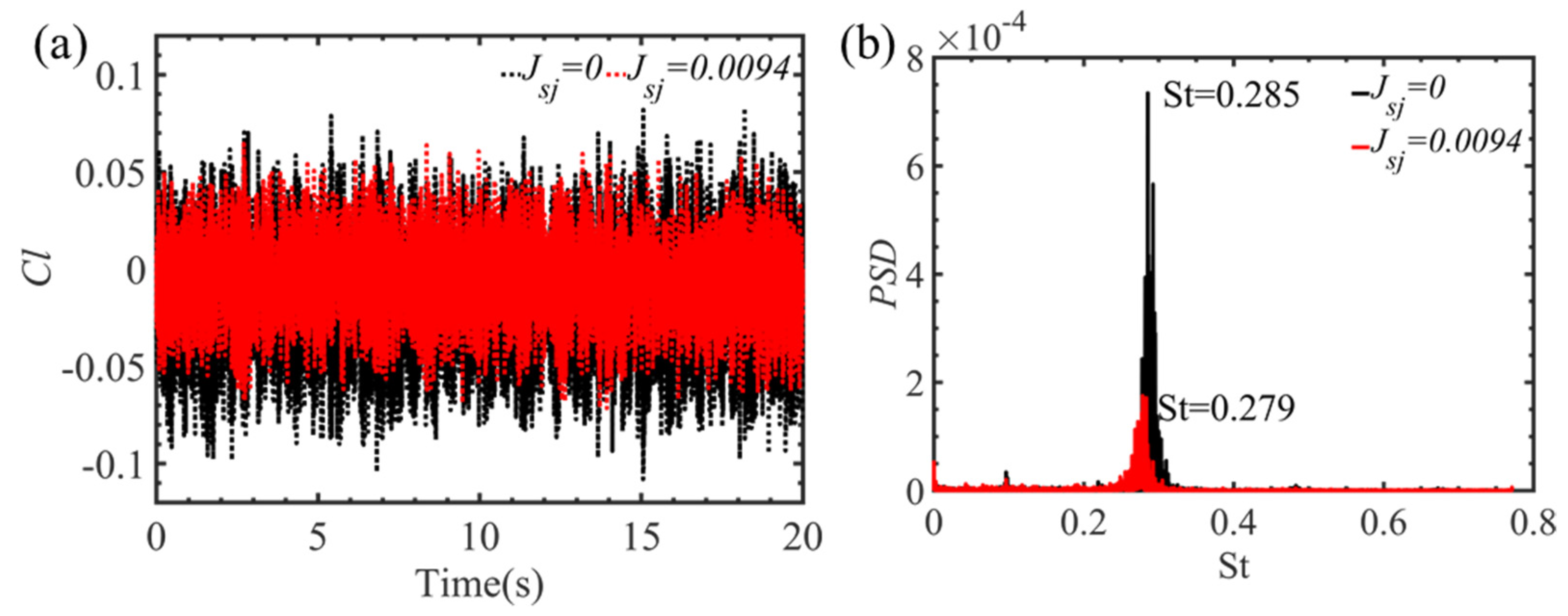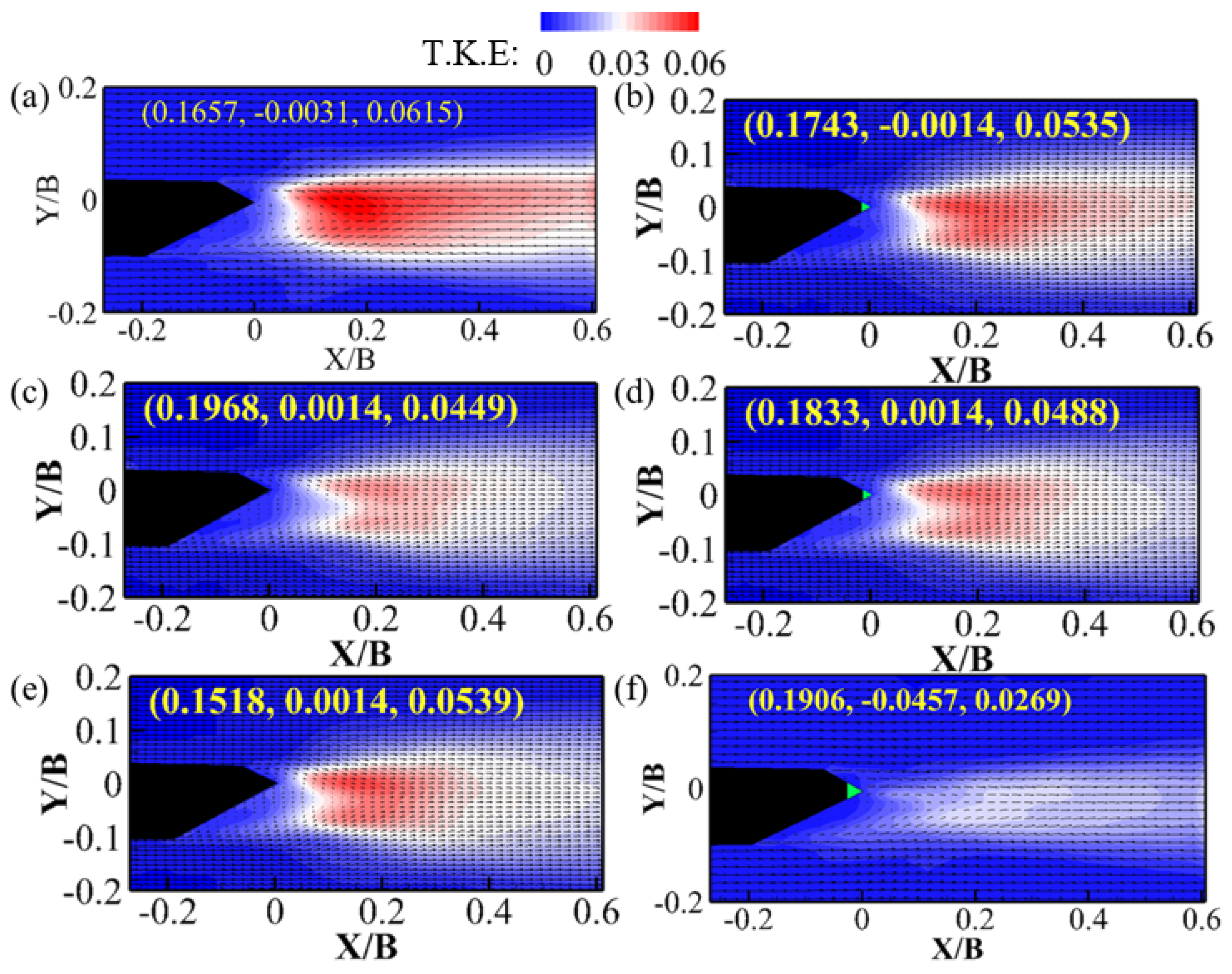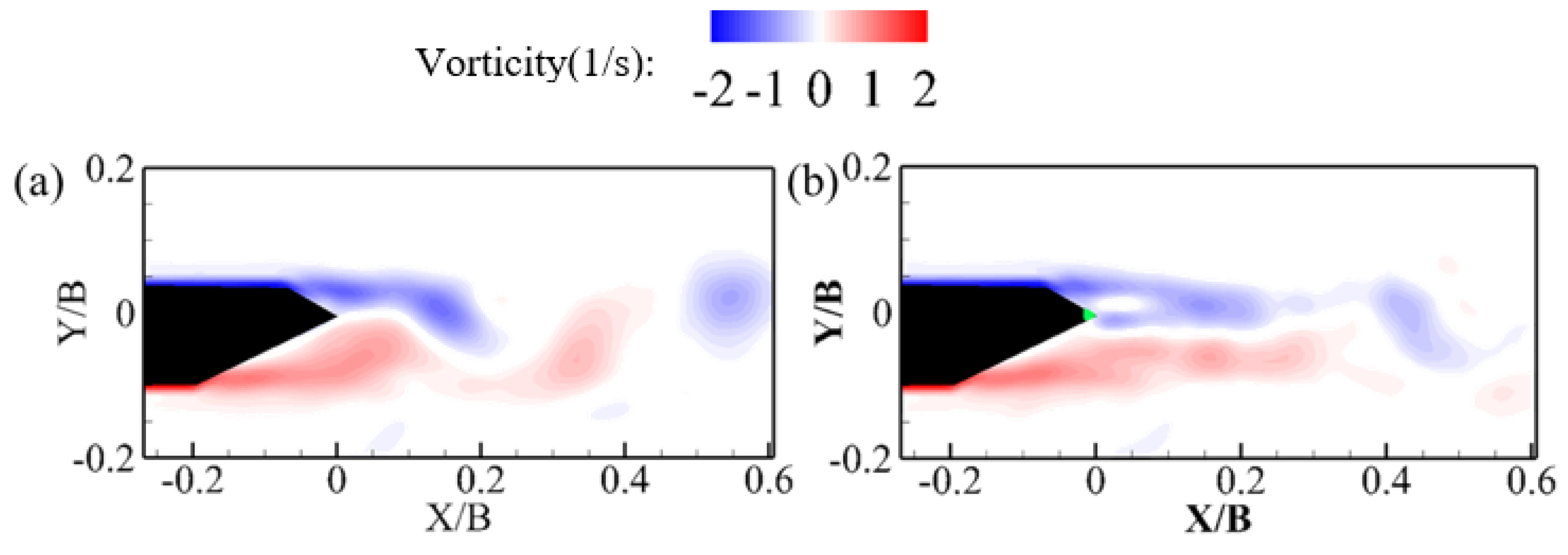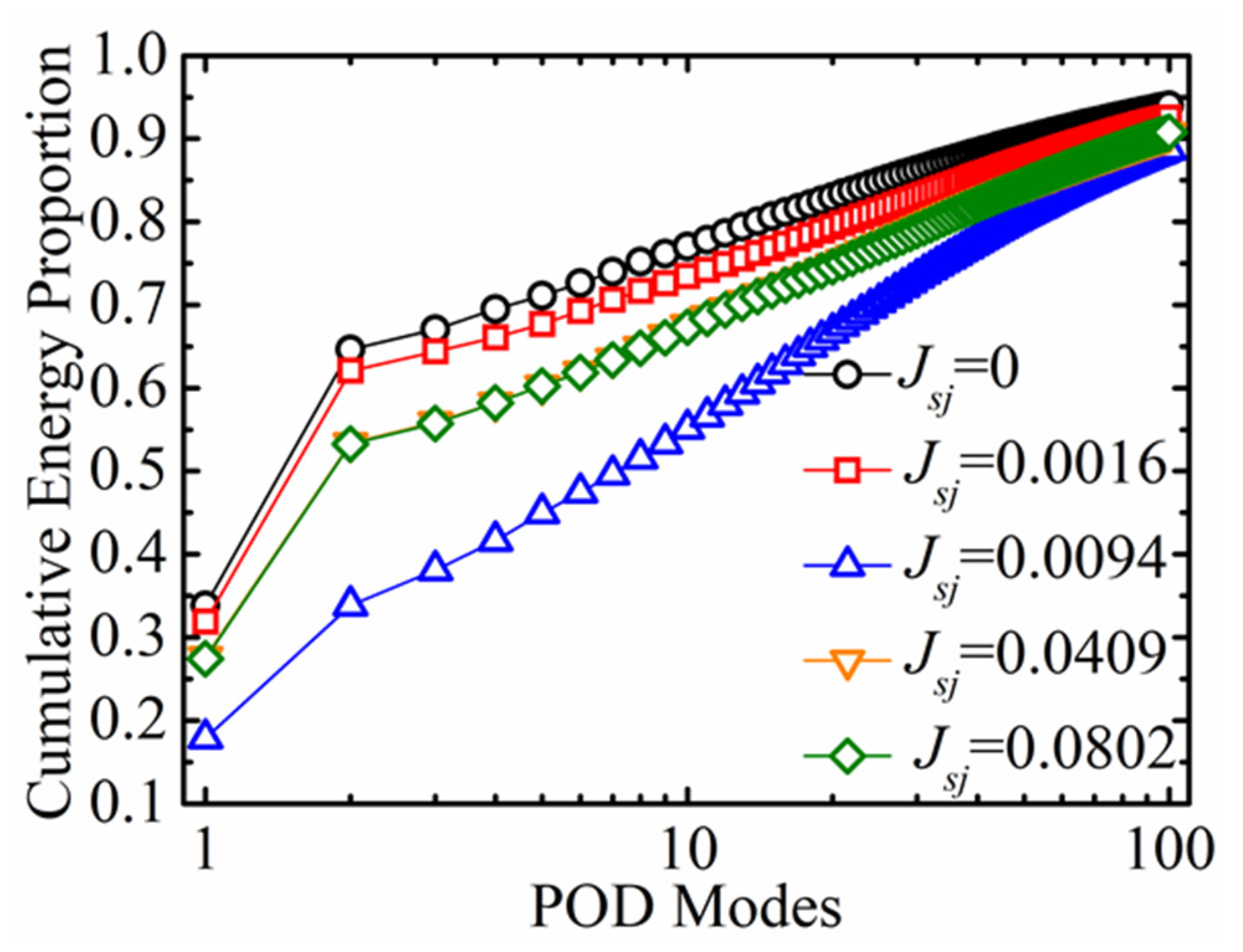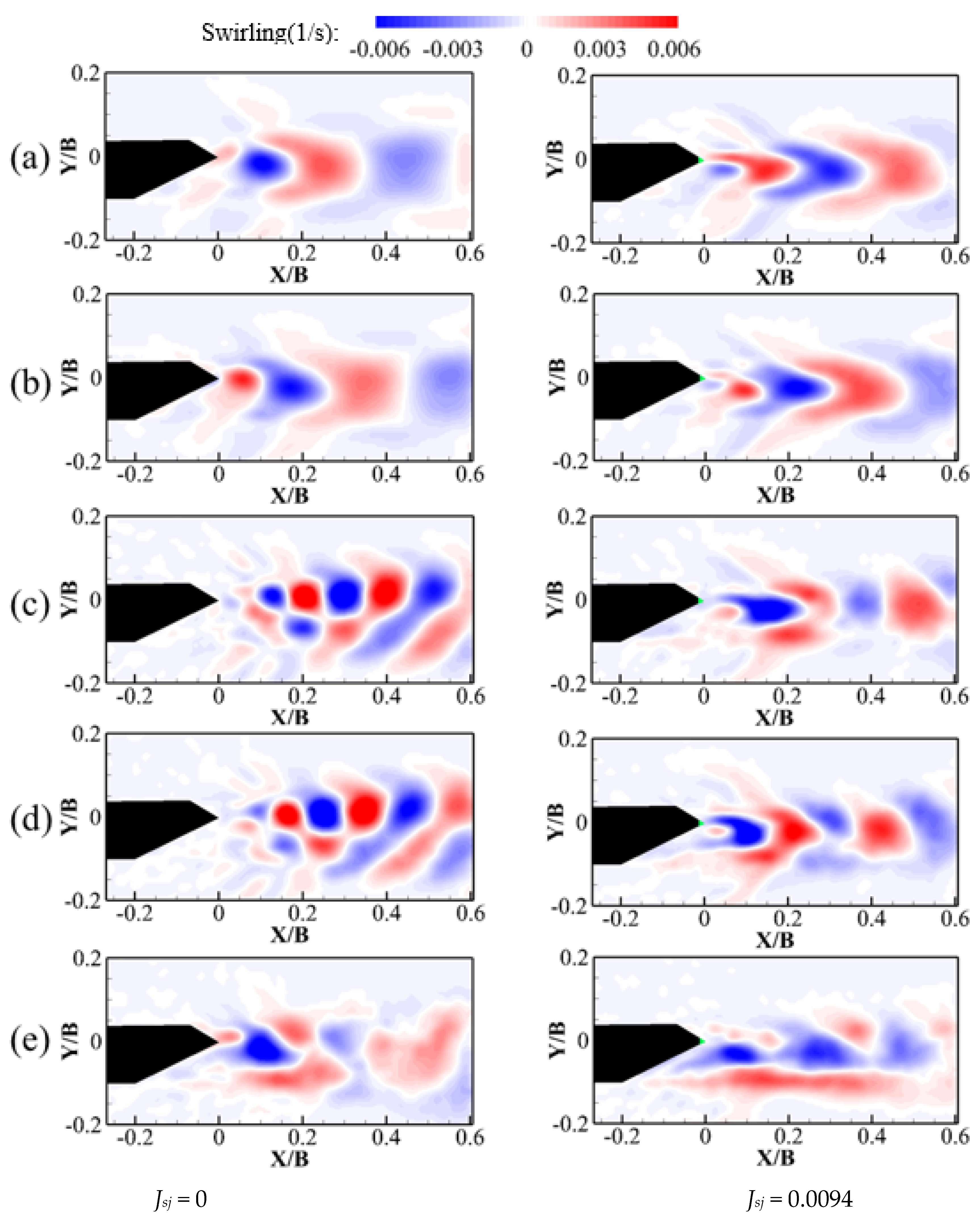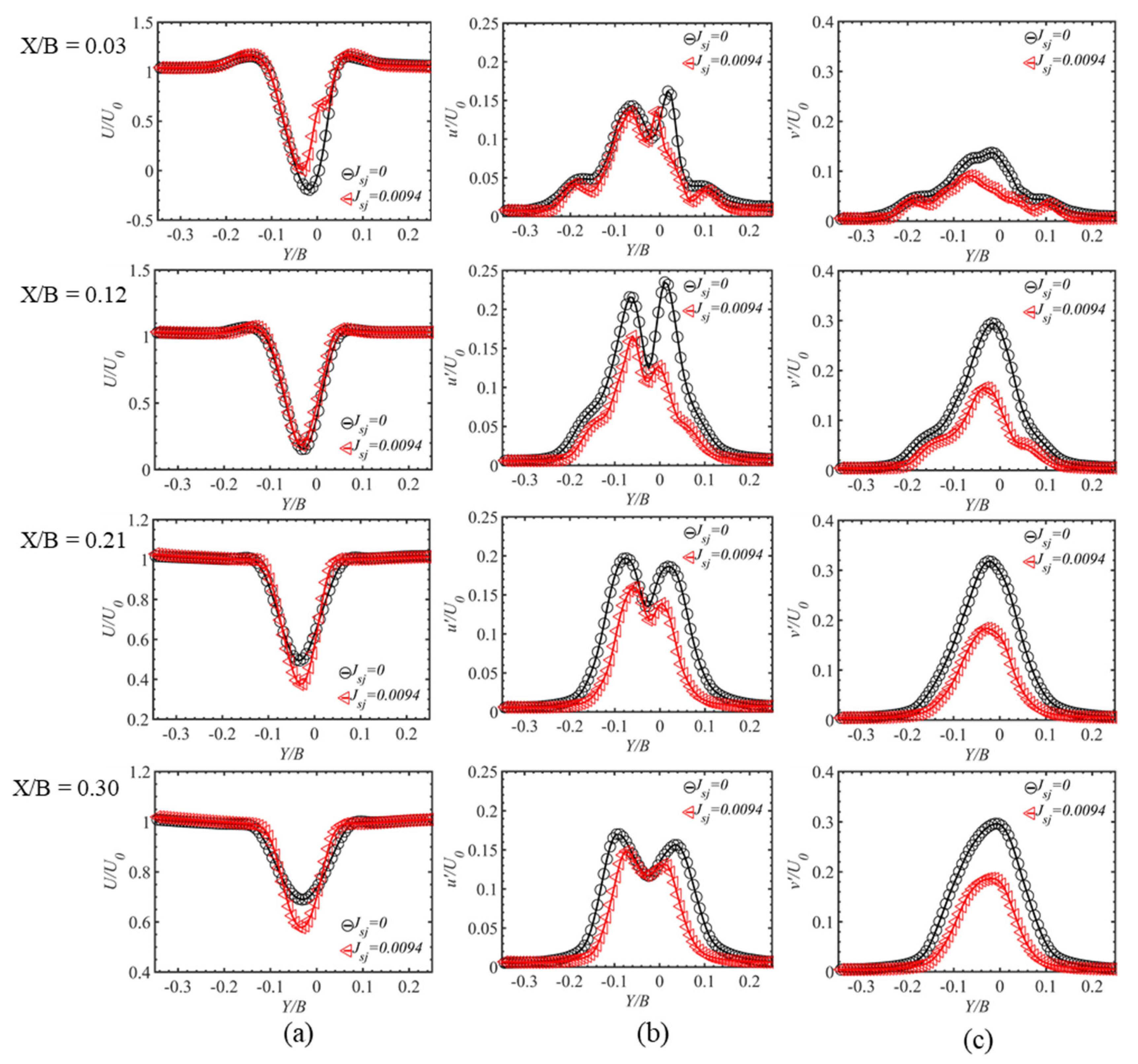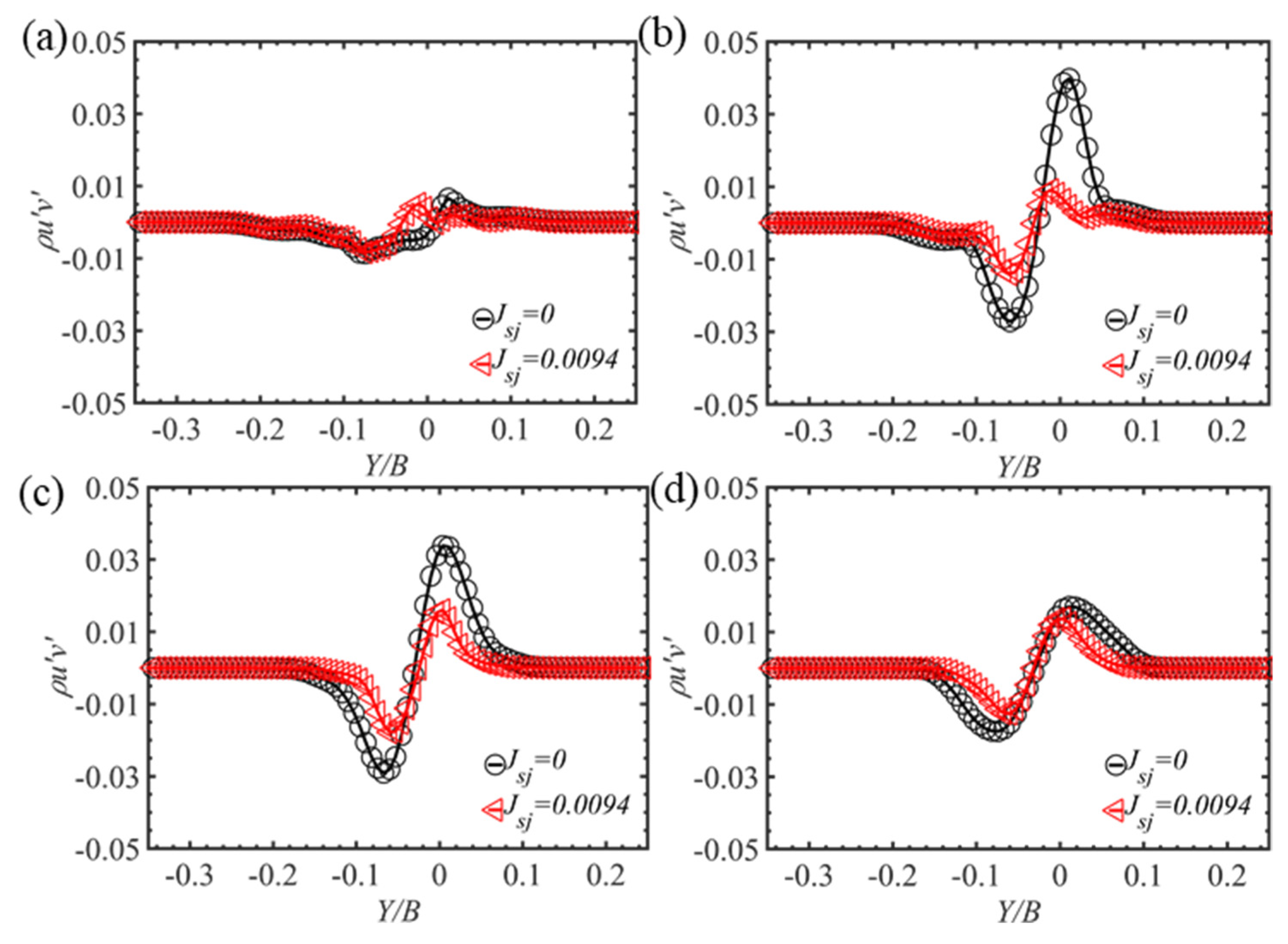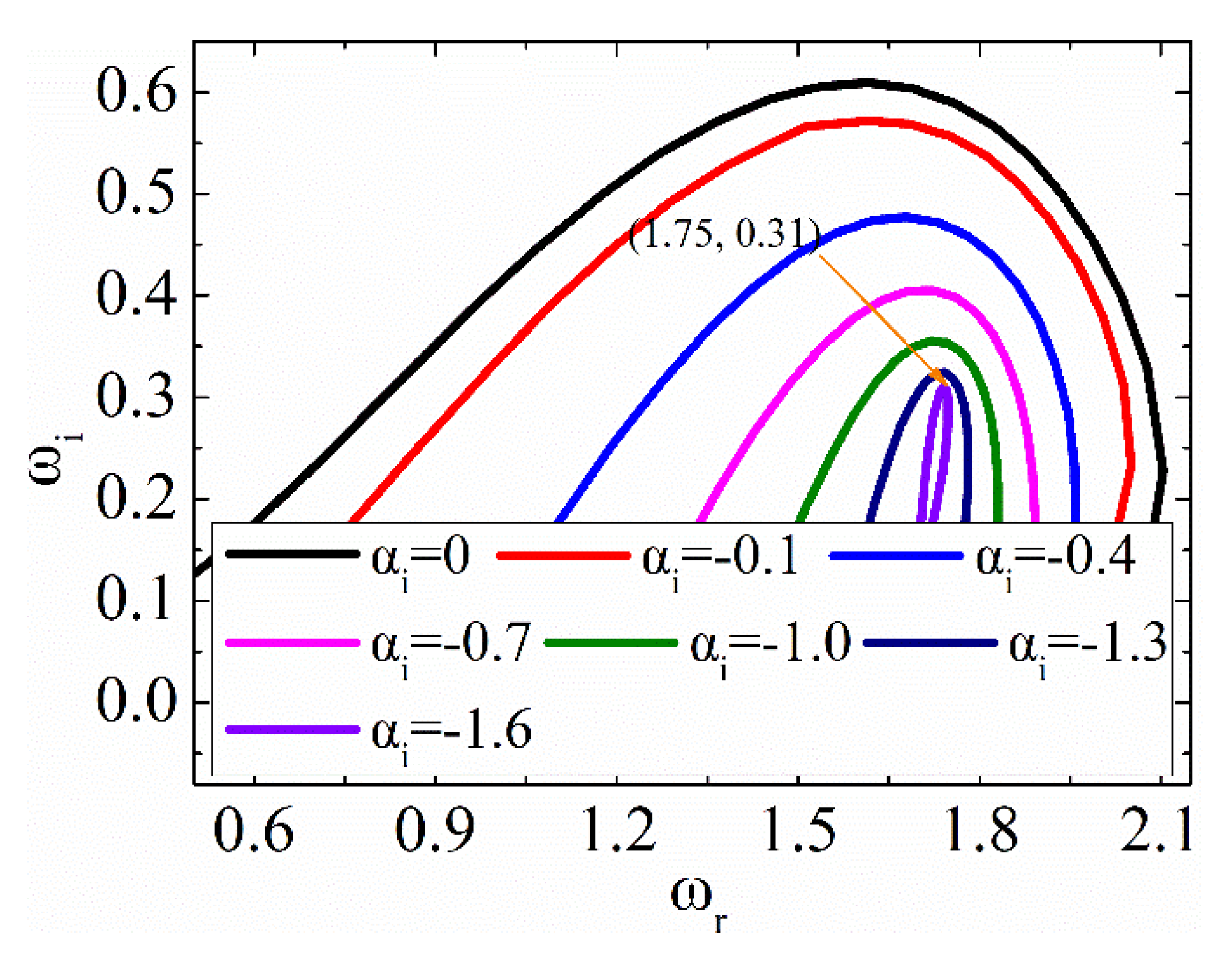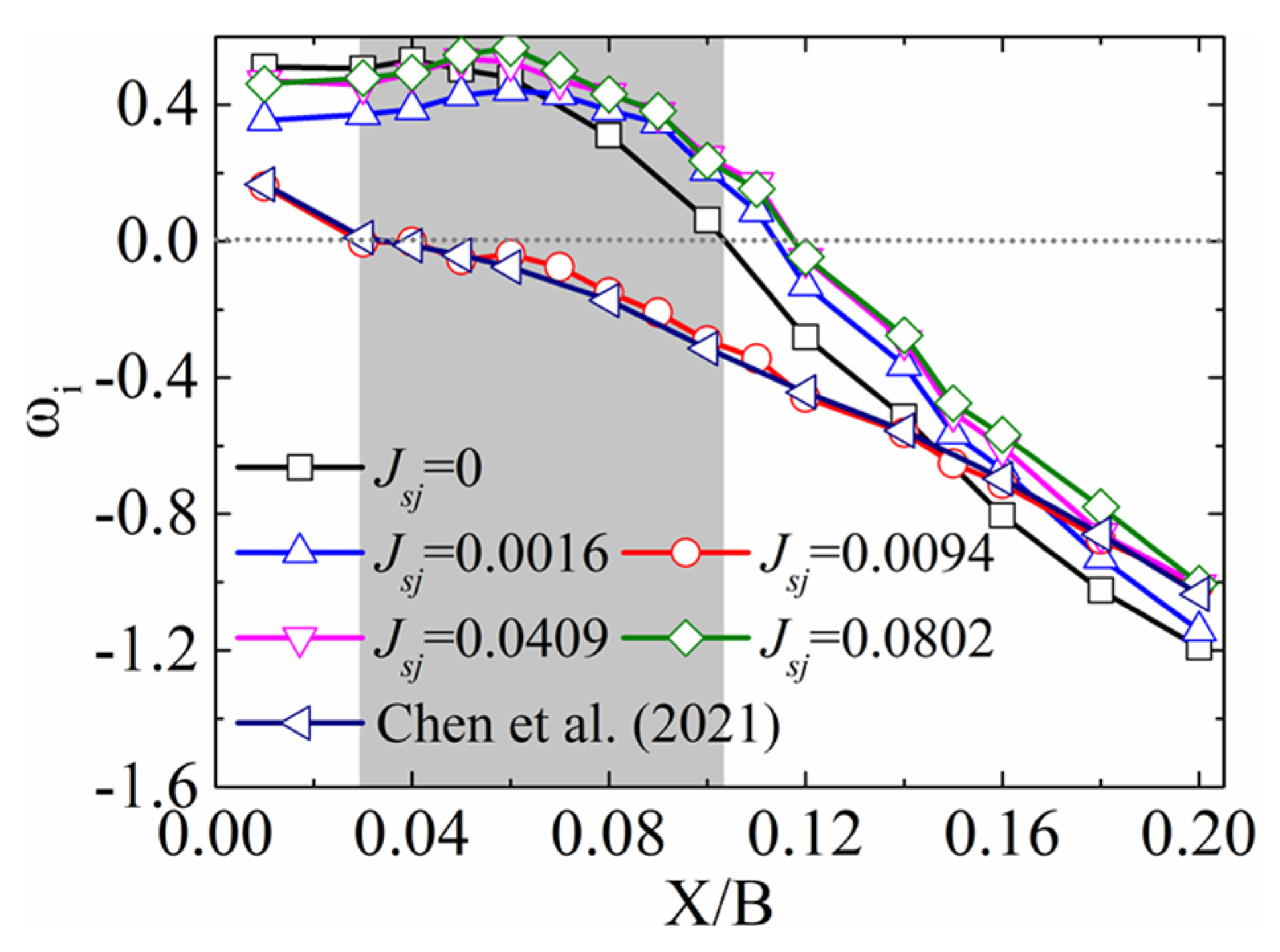3.1. Surface Pressure Distribution
The pressure coefficient (
) was that the surface pressure results that were acquired by the pressure measurement experiment were nondimensionalized by the dynamic pressure and defined as Equation (2). The mean value of the external surface pressure coefficient (
) was defined as Equation (3) to illustrate its average features. We used the standard deviation of the external surface pressure coefficient (
) to describe the fluctuating characters of the pressure distribution, as given in Equation (4).
where
is the static pressure that is acting on the surface SBG model and
is the static pressure of the free stream. The time histories of
and
are acquired and recorded by the digital pressure scanner.
is the air density and
N is the length of the total sample.
It should be illustrated that the surface pressure measurement plane was located in the central cross-section (i.e., plane II as given in
Figure 1a) was far away from the jet holes. The pressure distribution on other cross-sections may be different. However, the aerodynamic force that was acting on the present cross-section of the controlled case might underestimate the control ability due to the pressure measurement section being the farthest distance from the cross-section with trailing jet hole [
26]. The PIV result will confirm that.
Figure 4 gives the external surface pressure coefficient that was distributed around the SBG model that was equipped with and without trailing edge jets.
For the case
Jsj = 0, the mean pressure result of the upper surface on the SBG model shows a dramatic decrease due to an inflection point that existed between the pressure measurement taps 1 and 2. The adverse pressure gradient was observed at the range of X/B from 0.11 to 0.20, as shown in
Figure 4a. Therefore, the flow separation occurs in that position, causing the fluctuating pressure to have a maximal value at X/B = 0.11, as shown in
Figure 4c. As the X/B was larger than 0.20, the mean pressure distribution of the upper surface had similar values, except for the position of X/B = 0.5 and near the trailing edge. The upper external surface pressure distribution fluctuation shows an enormous value when X/B gets close to 1. The reason for this is that the position nearing the trailing edge will be more influenced by the alternating vortex shedding [
20,
26]. The adverse pressure gradient also appears in the lower surface of the SBG model at the position of X/B = 0.31–0.41 as shown in
Figure 4b, and the peak value of the fluctuating pressure coefficient was obtained at the position of X/B = 0.31, as given in
Figure 4d. Therefore, the local flow separation also occurred at the corner point between the pressure measurement taps 29 and 30. The other characteristics of the lower surface pressure are similar to those of the upper surface pressure.
When the jet holes were inserted in the SBG model, the external surface pressure was modified compared to that of the case
Jsj = 0. The mean values of the external surface pressure of the controlled case with different non-dimensional jet momentum coefficients remain close to the uncontrolled case at the position nearing the leading edge of the SBG model. When the pressure taps were located at the trailing edge, the mean value of the external surface pressure was alleviated by the trailing edge jet flow, and the case
Jsj = 0.0094 exhibited the best control effect. All the controlled cases can slightly attenuate the local flow separation at X/B = 0.11 of the upper surface of the SBG model, as shown in
Figure 4c, compared to case
Jsj = 0. However, the local flow separation was improved in the lower external surface of the controlled cases that caused a more considerable fluctuation of the pressure at X/B = 0.31, as given in
Figure 4d. The fluctuation of the surface pressure close to the trailing edge was mitigated on both the upper and bottom surfaces of the SBG model with the trailing edge jets. That is because the jet flow can interrupt the alternating vortex shedding and lead to the wake flow being more steady. According to the pressure measurement results, the case
Jsj = 0.0094 exhibited the best control ability for alleviating the mean value and fluctuation of the surface pressure. Obtaining better control effectiveness does not need larger non-dimensional jet momentum coefficients. There is an optimal non-dimensional jet momentum coefficient to realize the control effect, which is consistent with the study by Chen et al. [
20] and Gao et al. [
27].
3.2. Aerodynamic Force
The aerodynamic force can be obtained by integrating the surface pressure distributed around the SBG model. Afterward, the lift coefficient (
), drag coefficient (
), and the moment coefficient (
) are calculated by Equation (5).
where
,
, and
are the time-variant of the lift, drag, and moment force, respectively.
The aerodynamic coefficients that are acting on the SBG model that are equipped with and without control are displayed in
Figure 5. The mean value of the drag coefficient of the case where
Jsj = 0, which was consistent with the experimental results of 0.064 that were presented by Taylor et al. [
28], 0.061 by Zhang et al. [
9], and the numerical simulating result of 0.060 given by Frandsen [
29], was obtained as 0.062. With the increase of the
Jsj, both the mean value of the drag and lift coefficient shows a decrease at first and then an increase. However, the mean value of the moment coefficient of the controlled case maintained a closing value that was slightly large than the case where
Jsj = 0, indicating that the different
Jsj can not influence the moment force that is acting on the SBG model. Note that the main reason for the wind-induced vibration on the main girder is a large fluctuation of the aerodynamic force. The results of the fluctuation of the drag, lift, and moment coefficients that are acting on the SGB model with different
Jsj are displayed in
Figure 5d–f, respectively. The fluctuation of the aerodynamic coefficients were descending at first and then ascending with the increasing of
Jsj. Therefore, an optimal
Jsj for alleviating the unsteady aerodynamic force that is being exerted in the SBG model is required. This saturation phenomenon was also found by Chen et al. [
20], Gao et al. [
27], and Apelt et al. [
30]. When the
Jsj equals 0.0094, the best control ability was possessed in the present investigation. The control effect for the drag, lift, and moment coefficient fluctuation was 16.23%, 36.34%, and 38.74%, respectively. That conclusion agreed well with the results of the surface pressure analysis.
Figure 6 gives the time series and the power spectral density analysis of the lift coefficient being exerted in the SBG models with and without the trailing edge jets. The lift coefficient when
Jsj = 0 shows a significant fluctuation during the experiment, as shown in
Figure 6a. When the trailing edge jets were conducted in the SBG model with
Jsj = 0.0094, the fluctuation of the lift coefficient was reduced compared to the case
Jsj = 0. The peak value of the reduced frequency for the case
Jsj = 0 was obtained to be 0.285 based on the fast Fourier transform (FFT) analysis, which was similar to that of 0.28 that was presented by Taylor et al. [
28] and Chen et al. [
18]. The amplitude of power spectral density analysis of the case
Jsj = 0.0094 was lower than that of the case
Jsj = 0, and the peak value of reduced frequency of the lift force was also changed to 0.279, given in
Figure 6b. This indicates that the trailing edge jets that were equipped in the SBG model can modify the frequency and the strength of the vortex shedding behind the test model.
3.3. PIV Measurement Results
Besides the surface pressure measurement results, the PIV measurement experimental result can assist us in understanding the control mechanism of the trailing edge jets set in the SBG model.
Turbulence kinetic energy (TKE), which serves as a criterion to estimate the unsteady surface pressure and the fluctuating aerodynamic force that is acting on the SBG model [
31,
32,
33], is calculated as follows:
where
and
are the fluctuating velocity components of the streamwise and transverse direction, respectively.
The time-averaged flow fields behind the SBG model in the two target planes with and without the trailing edge jets are given in
Figure 7. A cluster of large values of the TKE is concentrated in the wake flow when
Jsj = 0, as shown in
Figure 7a. The reason is that the separation flows from the upper and bottom surfaces interact in the wake, leading to the velocity vectors colliding in this region. Therefore, the surface pressure distribution nearing the trailing edge when
Jsj = 0 shows a dramatic fluctuation. As the trailing edge jets is conducted in the SBG model, the distribution area and maximum value of the TKE are reduced. Moreover, the maximum value of the TKE decreases at first and then increases with the enhancement of
Jsj, as shown in
Figure 7a–e, which can explain the changing trend of the fluctuation of the aerodynamic force that is being exerted in the SBG model. Compared to results from the target plane II, both the maximum value and the concentrated area of TKE in the target plane I of the case
Jsj = 0.0094 is reduced as shown in
Figure 7c,f. The unsteady aerodynamic force being exerted in the cross-section of plane I is lower than that of plane II, indicating the pressure measurement result that was obtained by plane II would underestimate the control effectiveness of a fluctuating value of surface pressure that is distributed on the SBG model with trailing edge jets. Moreover, the lower TKE value illustrates that the level of turbulence mixing in the wake flow of the controlled cases is lower than the uncontrolled case [
34].
The instantaneous flow field in plane I that is given in
Figure 8 illustrates the vortex shedding pattern behind the SBG model. A pair of asymmetric vortices alternating shed from the upper and bottom surface of the SBG model and a Karman vortex street can be obtained in the wake flow, which causes the significant fluctuation of the surface pressure on the trailing edge of the test model without control, as shown in
Figure 4. The position where the upper and lower vortices interact leads to the enormous TKE value, which can be seen when comparing
Figure 7a and
Figure 8a. However, when the trailing edge jets work, a pair of symmetric vortices are formed in the wake flow field and the Karman vortex street is alleviated. The length of the vortex shedding is elongated and shifted further downstream, as given in
Figure 8b. In addition, the jet flow interacts with the upper vortex and divides that vortex into some small-scale vortices, illustrating that the unsteady aerodynamic force that is being exerted in the SBG model is mitigated, and then the potential vortex-induced vibration can be prevented with the trailing edge jets [
26].
At first, the proper orthogonal decomposition (POD) method was presented in the region of fluid mechanics by Lumley [
35]. The snapshot POD that was introduced by Sirovich [
36] was utilized in the present investigation. Here, every instantaneous photo that was obtained by the PIV experiment served as a snapshot of the flow structure. The autocovariance matrix was accepted by the product of the matrix of fluctuating part of the two-dimensional velocity and its transpose. The eigenvalues and the eigenvectors of the autocovariance matrix can be obtained. Afterwards, the accumulative energy proportion of each POD mode can be calculated by the eigenvalues of the autocovariance matrix, and the POD modes can be constructed from the basis built up from the snapshots.
Figure 9 shows the percentage of the accumulative contribution of every POD mode to the total turbulence kinetic energy of the flow field for the different test cases in PIV measurement. It is observed that the first two POD modes possess 64.6% of the total energy for the case
Jsj = 0. The first two POD modes represent the large-scale coherent structure, and the high-order POD modes represent the small-scale coherent structure as given by Feng et al. [
37]. Therefore, the large-scale coherent structure plays an important role in the wake flow behind case
Jsj = 0. When the control method is applied in the SBG model, the energy of each POD mode that is exhibited immensely changes. The total energy of the first two POD modes is slightly decreased, as
Jsj is set as 0.0016, indicating that a little strength of the jet flow cannot significantly influence the vortex. The ratio of the energy of the first and second POD modes to the total kinetic energy for cases
Jsj = 0.0016,
Jsj = 0.0094,
Jsj = 0.0409, and
Jsj = 0.0802 are 62.0%, 33.8%, 53.3%, and 53.2%, respectively. Hence, the total energy of the first two POD modes decreases at first and then increases, as shown in
Figure 9 when
Jsj improves. Moreover, the small-scale coherent structures in the wake flow field behind case
Jsj = 0.0094 occupy most of the energy for the global flow structure, which alleviates the large amplitude of the unsteady aerodynamic force that is being exerted in the SBG model compared to the case
Jsj = 0.
To identify the characters of the POD modes, the first five POD modes for cases
Jsj = 0 and
Jsj = 0.0094 are plotted in
Figure 10. For the case where
Jsj = 0, the first two dominant POD modes are symmetrical about the line Y/B = 0.02 and exhibit alternating vorticity that is distributed in the wake flow. Nevertheless, modes three to five vary from modes one and two: modes three and four are asymmetrical about the line Y/B = 0.02. There are two rows of counter-rotating vorticity concentrations that are displayed in the flow field behind the case
Jsj = 0 closed to the test model and then changed into the arrowhead structures as the flow field moves downstream, as shown in
Figure 10c,d. Moreover, mode five shows some a small-scale vorticity concentration behind case
Jsj = 0. The antisymmetric vorticity flow fields that are calculated by POD represent the symmetric features of the vortex flow field. Conversely, the symmetrical vortex flow structures stand for an antisymmetric flow field, as Konstantinidis et al. [
38] described. In consequence, modes one and two of the case
Jsj = 0 stand for the large-scale alternating vortex shedding forming the Karman vortex street, while modes three and four denote the small spatial scale vortices with symmetric forms, and mode five represents the irregular distribution of the vorticity structures with small geometric scale. For the SBG model with the trailing edge jets, the flow structures of POD modes show noticeable differences that are in contrast to their counterparts of the uncontrolled case. The vortex concentrations of the case
Jsj = 0.0094 are dramatically decreased and narrowed laterally and stretched in the flow direction, as shown in the right of
Figure 10. This phenomenon of the POD modes is in connection with the elongation of the wake vortex, as shown in
Figure 8b. In addition, the wake jet flow disturbs the vorticity. It divides it into two small parts at the nearing wake position as shown in modes one to four, and mode five changes to much smaller vorticity concentrating parts compared with case
Jsj = 0. Based on the analysis above, the wake flow structure characteristics of the case
Jsj = 0.0094 yield the unsteady aerodynamic force that is less than that of case
Jsj = 0, which is consistent with the results in
Section 3.2.
To analyze the difference of the velocity profile in the flow field behind the test model with and without the trailing edge jets, the means of the streamwise velocity, streamwise velocity fluctuation, and the transverse velocity were extracted from the PIV measurement plane I. The time-averaged streamwise velocity that was located in different positions of X/B is given in
Figure 11a. The velocity profile of the case
Jsj = 0 is asymmetrical in the location that is close to the SBG model and symmetrical in a further downstream position. The reason is that the geometric shape of the SBG model is asymmetrical along the line of Y/B = 0. The lowest velocity of the case
Jsj = 0 was less than that of the case
Jsj = 0.0094 at X/B = 0.03 and 0.12 because the jet flow can alleviate the velocity defect. That indicates the inner region flow field behind case
Jsj = 0.0094 is more stable than the case
Jsj = 0 [
6]. Conversely, the smallest value of the velocity of the case
Jsj = 0 was larger than that of case where
Jsj = 0.0094 at X/B = 0.21 and 0.30. The velocity profile of the case
Jsj = 0 regained faster than that of the case
Jsj = 0.0094. Moreover, the width of the wake flow in case
Jsj = 0 was slightly wider than the case
Jsj = 0.0094, indicating the large drag force that was acting on the SBG model without control [
20].
Figure 11b shows the fluctuation of the streamwise velocity profile at various positions in the wake. For the case
Jsj = 0, There are two peak values that were observed in the wake flow of the case at X/B = 0.03–0.30, i.e., double-cusp mode. The maximum values appear when the turbulence level grows a dramatically quick ratio, mainly in the shear layers of the separation flow [
33]. However, owing to the trailing edge jet flow disturbing the original flow field a the near-wake of X/B = 0.03, this profile for the controlled case exhibited a quadruple cusp mode. The fluctuation of the streamwise velocity profile of the case
Jsj = 0.0094 presented a double-cusp mode at X/B = 0.12–0.30. It was similar to that of the case
Jsj = 0, illustrating that the jet flow has a short influence range, which is identical to the investigation by Chen et al. [
20]. Moreover, the peak value of the streamwise velocity fluctuation for case
Jsj = 0.0094 was lower than the case
Jsj = 0 at all the positions, leading to the unsteady drag force that was being exerted in the SBG model being mitigated.
The profiles of the transverse velocity fluctuation for cases
Jsj = 0 and
Jsj = 0.0094 are plotted in
Figure 11c. The maximum value appears at approximately Y/B = 0.02, which is the axis of symmetry for the wake flow. The shear layers that are formed from the upper and lower surface are amalgamated and violently interact, causing a significant transverse velocity fluctuation [
18,
20]. The peak value of the case
Jsj = 0 shows an increasing trend at the locations of X/B = 0.03 to 0.21 and then a reduction when X/B is more significant than 0.21, which illustrates that the shear layer interaction in the wake flow nearing to the SBG model is weaker than that of downstream. The maximum value of the fluctuation of the transverse velocity for the case
Jsj = 0.0094 is obviously alleviated at all positions, indicating that the strong interaction of the shear layer decreased. That leads to the unsteady lift force that is acting on the SBG model when the trailing edge jets attenuated, as shown in
Figure 5.
The Reynolds shear stress (RSS), which serves as an essential parameter to represent the turbulence in the flow structure, is calculated and given in
Figure 12. At the near-wake of X/B = 0.03, the RSS possesses a lower value, illustrating the low turbulence level in this area for the case
Jsj = 0. The maximum value of RSS is increased at first and then decreased with the improvement of the X/B. The maximum and minimum values of the RSS are obtained at the Y/B = ~−0.01 and 0.06, respectively, because the turbulence level of the shear layer that is separated from the upper and lower surface of the SBG model is strong [
33]. This causes a significant fluctuation of the lift force being exerted in the SBG model. As
Jsj sets as 0.0094, the RSS is mitigated at all the positions in wake flow, and the maximum and minimum values are reduced related to the uncontrolled case, which indicates that the interacting strength of the upper and lower shear layer is mitigated in the wake flow behind SBG model. Therefore, the unsteady lift force is decreased by the trailing edge jets.
3.4. Linear Stability Analysis
Triantafyllou et al. [
39] found that the absolute instability of the flow field behind a bluff body is the reason for the vortex appearing in the wake of a stationary bluff body. The time-averaged streamwise velocity profiles, that were extracted from the mean flow field at various locations as shown in
Figure 11a, substitute into the inviscid Orr–Sommerfeld equation (OSE). It should be noted that the higher-order small-term occurring in deducing the Orr–Sommerfeld equation and the viscidity of the air is neglected. Solving the OSE obtains the critical value in the complex frequency plane and the stability of the velocity profile by using the mathematical method that was presented by Orszag [
40]. The imaginary part of the complex frequency, named as
, determines the stability of the flow structure behind the SBG model. A positive
represents an unstable flow structure because the slight disturbance would evolve over time, leading to a large unstable flow structure [
20]. Contrary, the small initial disturbance would vanish with time for a negative
.
Figure 13 presents the dispersion relation
maps
constant lines on the
plane that were obtained by solving the OSE using the velocity profile at the position
X/B = 0.08 of case
Jsj = 0. The
is the complex wave number, and the
is the imaginary part of
. The imaginary and real parts of the complex frequency at the cusp point are 0.31 and 1.75, respectively. This indicates the velocity profiles behind case
Jsj = 0 at
X/B = 0.08 is absolute instability, causing the TKE to exhibit a considerable value in the wake flow, as shown in
Figure 7a. According to the real part of
, the Strouhal number of the wake flow can be calculated as 0.28, which is close to that which is gained by using the power spectral density analysis for the lift force that is acting on the SBG model as given in
Figure 6b.
The
at various locations behind the SBG model with and without trailing edge jets are obtained as given in
Figure 14. It can be observed that the ranges of the absolute instability are stretched to the position of X/B = 0.103 for the case
Jsj = 0. The flow field was slightly stable at the near-wake, and the unstable region was broader for cases
Jsj = 0.0016, 0.0409, and 0.0802. However, for the case
Jsj = 0.0094, the unstable area was narrowed to X/B = 0.029, indicating the unstable range decreased about 71.84% compared to that of the case
Jsj = 0 as shown in the grey region of
Figure 14. This phenomenon demonstrates that too strong jet flow isn’t needed for controlling the unstable flow field of the SBG model with a trailing edge jet. An appropriate jet-speed causes a steadier flow structure behind the bluff body, which is also uncovered by Gao et al. [
41] in investigations of suppressing unsteady aerodynamic force that is being exerted in a circular cylinder. Therefore, a steady flow structure would excite the lower fluctuating amplitude of the aerodynamic force that is acting on the SBG model, as given in
Figure 5. Moreover, the stability of the wake flow of the case
Jsj = 0.0094 is similar to that of the studies of leading-edge suction and trailing-edge jet (LSTJ) that are presented by Chen et al. [
20]. The superiority of the present control scheme is that the energy consumption of the case
Jsj = 0.0094 is half of that of the control method of LSTJ because the present control method only needs the trailing edge jets, not the leading-edge suction.
